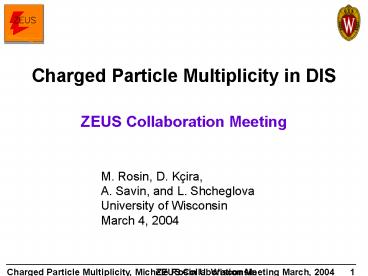Charged Particle Multiplicity in DIS - PowerPoint PPT Presentation
1 / 15
Title:
Charged Particle Multiplicity in DIS
Description:
Charged Particle Multiplicity, Michele Rosin U. Wisconsin ... M. Rosin, D. K ira, A. Savin, and L. Shcheglova. University of Wisconsin. March 4, 2004 ... – PowerPoint PPT presentation
Number of Views:71
Avg rating:3.0/5.0
Title: Charged Particle Multiplicity in DIS
1
Charged Particle Multiplicity in DIS
- ZEUS Collaboration Meeting
M. Rosin, D. Kçira, A. Savin, and L.
Shcheglova University of Wisconsin March 4, 2004
2
Outline
- Universal dependence of mean charged
multiplicity, ltnchgt, on effective energy going
into particle production, Whad, for ee-, pp, and
ep. - Introduction of Meff and motivation for its use
as an energy scale - Data selection simulation
- Resolutions and systematics
- Measurements of ltnchgt vs. effective mass
- Comparison to second analysis
- Summary and plan
3
Early experimental evidence for universality
- In the current region of the Breit
frame, Q for ep reactions corresponds to
Whad for ee- reactions - Mean charged multiplicity, ltnchgt , vs. Q
shows logarithmic dependence for both ee-
and ep on the effective energy going into
hadronization - Universal dependence of ltnchgt observed in
ee- and ep reactions in Breit frame
ee-
ep
4
Motivation for the use of Meff as energy scale
Similarity of particle production at ee- and ep
colliders
Whad
- Similarity of Whad dependence on ltnchgt has been
observed - A common Whad dependence on ltnchgt implies the
production of secondary particles is similar in
the different interactions - Study the dependence of ltnchgt of the observed
part of the produced HFS on its total invariant
mass, Meff
Whad
Meff
Whad HFS measured in full phase space Meff HFS
measured in the detector where the tracking
efficiency is maximized
5
1996-97 Data sample
- Event Selection
- Scattered positron found with E gt 12 GeV
- A reconstructed vertex with Zvtx lt 50 cm
- scattered positron position cut x gt 15 cm or
y gt 15cm (in RCAL) Box cut - 40 GeV lt E-pz lt 60 GeV
- Track Selection
- Tracks associated with primary vertex
- ? lt 1.75
- pT gt 150 MeV
- Physics and Kinematic Requirement
- Q2 da gt 25 GeV2
- y el lt 0.95
- y JB gt 0.04
- 70 GeV lt W lt 225 GeV ( W2 (q p)2 )
8,700,692 events before cuts 208,550 events
after all cuts
6
Event simulation
- Ariadne 97 6v2.4
- Matrix elements at LO pQCD O(?s)
- Parton showers CDM
- Hadronization String Model
- Proton PDFs CTEQ-4D
(Simulates both 96 and 97 data no changes in
detector)
747,003 events before cuts 50,884 events after
all cuts
7
Eta dependent study using generated events
- The dependence of ltnchgt on the Meff of the
produced system for ep generated events is
the same in different regions of phase
space - Can use the observed part of the
produced hadronic final state, with good
tracking(h lt 1.75) for studying this
dependence - Impact of restricted h measurement on Meff
8
Resolutions of kinematic variables
s 6.6
s 9
- Resolutions well behaved
- Use standard deviations for excursions
in systematic studies
s 15.5 cm
s 22
s 6.8
s 10
9
Correlated Uncorrelated Systematics
10
1995 ZEUS measurement in lab frame
ZEUS 95 PRELIMINARY RESULT (never published)
- Compare ltnchgt vs. Meff dependence in ee-,
pp, and ep (ZEUS). universality? - ltnchgt proportional to log Meff
- ltnchgt 15 above corresponding ee-
- Suggestion difference due to ep color
dynamics at the pre- hadronization stage.
11
ltnchgt vs. Meff 96-97 vs 95
- This analysis compared to 1995 study
- Data corrected to hadron level
- Full error bars statistical systematic
uncertainties added in quadrature - Inner error bars statistical uncertainties
- Reasonable agreement with 1995 ZEUS
preliminary result
12
Comparison to 2nd analysis
2nd Analysis by Dorian Kçira
13
Trigger studies by L. Shcheglova
Lydia has investigated the possibility to go to
lower Q2. Because of changing prescales for DIS01
and changing radius for DIS03, must use a
weighting scheme Created a mixed sample of DIS01
DIS03 to get agreement with MC The weighting
scheme is described in detail here http//amzeus.
desy.de/sumstine/trigger_study/weighting_foils.ps
14
Results of reweighting
Good agreement between data and MC down to Q2
15 or 10 GeV2 Currently Q2 gt 25, but lowering Q2
cut can increase the kinematic lever arm
15
Summary
- The dependence of ltnchgt on the Meff of the
produced system for ep generated events is the
same for restriced eta reigions - Systematic errors are small, dominated by CAL
energy scale - Trigger study shows possibility of going to lower
Q2 - Agreement between 1st and 2nd analyses less than
1 - ltnchgt vs. Meff agrees with 1995 ZEUS preliminary
results - Plan
- Generate more ARIADNE to increase statistics
- Generate LEPTO monte carlo for systematic studies































